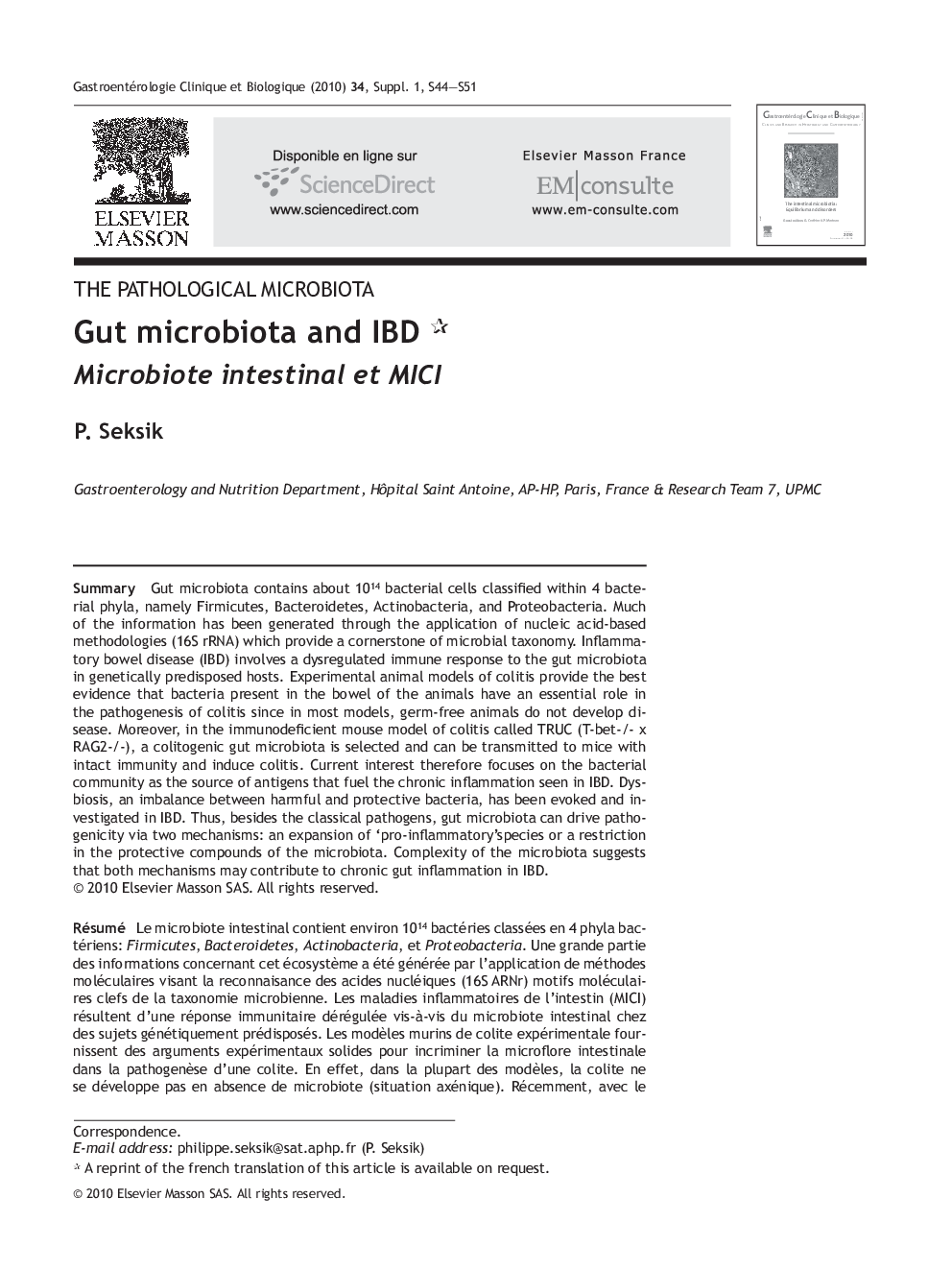| کد مقاله | کد نشریه | سال انتشار | مقاله انگلیسی | نسخه تمام متن |
|---|---|---|---|---|
| 3290267 | 1209683 | 2010 | 8 صفحه PDF | دانلود رایگان |

SummaryGut microbiota contains about 1014 bacterial cells classified within 4 bacterial phyla, namely Firmicutes, Bacteroidetes, Actinobacteria, and Proteobacteria. Much of the information has been generated through the application of nucleic acid-based methodologies (16S rRNA) which provide a cornerstone of microbial taxonomy. Inflammatory bowel disease (IBD) involves a dysregulated immune response to the gut microbiota in genetically predisposed hosts. Experimental animal models of colitis provide the best evidence that bacteria present in the bowel of the animals have an essential role in the pathogenesis of colitis since in most models, germ-free animals do not develop disease. Moreover, in the immunodeficient mouse model of colitis called TRUC (T-bet-/- x RAG2-/-), a colitogenic gut microbiota is selected and can be transmitted to mice with intact immunity and induce colitis. Current interest therefore focuses on the bacterial community as the source of antigens that fuel the chronic inflammation seen in IBD. Dysbiosis, an imbalance between harmful and protective bacteria, has been evoked and investigated in IBD. Thus, besides the classical pathogens, gut microbiota can drive pathogenicity via two mechanisms: an expansion of ‘pro-inflammatory'species or a restriction in the protective compounds of the microbiota. Complexity of the microbiota suggests that both mechanisms may contribute to chronic gut inflammation in IBD.
RésuméLe microbiote intestinal contient environ 1014 bactéries classées en 4 phyla bactériens: Firmicutes, Bacteroidetes, Actinobacteria, et Proteobacteria. Une grande partie des informations concernant cet écosystème a été générée par l’application de méthodes moléculaires visant la reconnaisance des acides nucléiques (16S ARNr) motifs moléculaires clefs de la taxonomie microbienne. Les maladies inflammatoires de l’intestin (MICI) résultent d’une réponse immunitaire dérégulée vis-à-vis du microbiote intestinal chez des sujets génétiquement prédisposés. Les modèles murins de colite expérimentale fournissent des arguments expérimentaux solides pour incriminer la microflore intestinale dans la pathogenèse d’une colite. En effet, dans la plupart des modèles, la colite ne se développe pas en absence de microbiote (situation axénique). Récemment, avec le modèle de souris immunodéficientes de colite appelée TRUC (T-bet– /– x RAG2– /– , ulcerative colitis), un nouveau paradigme a emergé puisque le microbiote intestinal semble pouvoir transmettre la colite suggérant ainsi l’existence d’un microbiote ‘colitogénique’. Un intérêt grandissant centré sur l’étude des communautés bactériennes comme source antigénique alimentant l’inflammation chronique au cours des MICI a vu le jour. Une dysbiose, i.e. un déséquilibre entre des bactéries ‘délétères’et ‘bénéfiques’, a été évoquée et recherchée dans les MICI. A côté des agents pathogènes classiques, le microbiote intestinal pourrait porter une pathogénicité de deux façons: par l’expansion d’espèces «proinflammatoires» ou par la diminution de bactéries protectrices « anti-inflammatoires ». La complexité du microbiote suggère que ces deux mécanismes pourraient contribuer à l’inflammation intestinale chronique rencontrée au cours des MICI.
Journal: Gastroentérologie Clinique et Biologique - Volume 34, Supplement 1, September 2010, Pages S44-S51